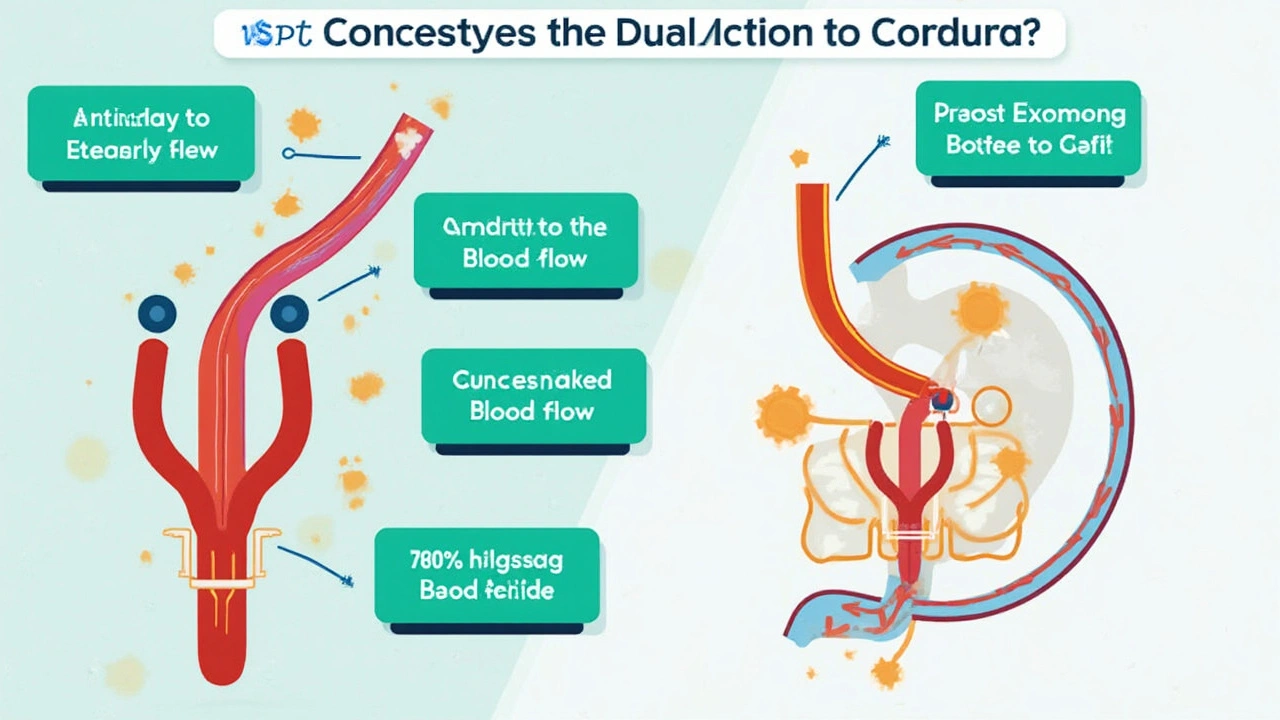 Jun, 23 2025
Jun, 23 2025
Cardura isn’t the kind of medicine you casually chat about over coffee. But ask around, and you’d be surprised how many older guys know someone who takes it—or maybe pops it themselves. It’s not something you hear about on billboards or slick ads, but in urology and heart clinics, it’s a familiar face. Cardura, with the generic name doxazosin, has quietly helped millions handle two major issues that can make life uncomfortable: high blood pressure and an enlarged prostate, also known as benign prostatic hyperplasia (BPH). If you’re looking for just the basics—what it does, side effects, and how it could fit into real life—you’re in the right place.
What Exactly Is Cardura and How Does It Work?
First off, Cardura belongs to a class of drugs known as “alpha blockers.” It isn’t your typical blood pressure pill. Alpha blockers work by relaxing blood vessels—basically opening the plumbing so blood can move more easily through your body. That’s why it’s prescribed for hypertension (that’s doctor-speak for high blood pressure). But here’s where Cardura gets even more interesting: it also helps men who start finding themselves stuck in the bathroom at 2 a.m., struggling to get a steady stream. This is BPH doing its thing, making peeing a slow, frustrating challenge. Cardura relaxes the muscles in the prostate and bladder neck, letting urine flow more freely. So, you’ve got one medicine, two different but related jobs—helping the blood vessels and easing the muscles down below.
Now, don’t get the idea that Cardura is a one-size-fits-all fix or “natural” remedy. It was first approved in the early ’90s, a result of years of research. Now, decades later, most doctors trust it, but they don’t hand it out like candy. Cardura’s effects kick in pretty quickly for blood pressure—many folks see improvements within a week. For BPH, it can take 1-2 weeks to start noticing fewer bathroom trips and stronger flow, though everyone’s different. Dosage varies too, usually starting low (1 mg daily) and ramping up slowly. Why so cautious? Because Cardura can drop your blood pressure a bit too much, especially when you first stand up—known as orthostatic hypotension. Some people even faint if they jump out of bed too quickly after their first dose.
If you’re already taking other blood pressure or prostate drugs, make sure your doctor knows—drug interactions can get tricky fast. And actually, Cardura isn’t the only alpha blocker out there; its cousins include tamsulosin (Flomax) and prazosin, but each has its own quirks. For example, Flomax focuses more on the prostate and less on blood pressure. Doxazosin, the generic name, can be more flexible. Here’s a tip: some insurance covers the generic, but not the brand-name Cardura, so double check before heading to the pharmacy.
Who Should Take Cardura—and Who Should Avoid It?
Cardura is mostly recommended for adults, especially older men dealing with BPH, or anyone struggling with stubborn high blood pressure. But some people should steer clear. If you have a history of low blood pressure, severe liver problems, or you’ve fainted from blood pressure meds in the past, Cardura might not be a good fit. Women can take it for high blood pressure, but it’s not usually prescribed to them for other reasons.
People often ask whether you have to stay on Cardura forever. For blood pressure, it’s likely. Hypertension doesn’t take vacations, and suddenly stopping the drug can make your blood pressure jump. For BPH, if symptoms fade away (which sometimes happens with lifestyle changes or surgery), your doctor might try weaning you off.
Here’s something not everyone knows: if you’re scheduled for cataract surgery, always tell your eye surgeon if you’re taking Cardura. There’s a phenomenon called “floppy iris syndrome,” which makes eye surgery a bit trickier when you’re on alpha blockers. Most eye surgeons know about this now, but it’s worth repeating at your appointment just in case.
Pregnant women and breastfeeding mothers should skip Cardura, unless a doctor says otherwise—and that’s pretty rare. Kids hardly ever take it, with a few exceptions for special medical conditions under strict supervision. And here’s another warning: don’t double up on doses if you miss one—just skip and continue as usual. Overdosing can cause a dramatic drop in blood pressure, which can land you in the ER.

Common and Not-So-Common Side Effects
Side effects might sound boring, but they’re what most people really want to know about. With Cardura, the most common one is that sudden lightheaded feeling when you stand up—the classic “first-dose effect.” Doctors often tell folks to take their first pill at bedtime and get up slowly in the morning. That grogginess or dizziness usually goes away in days, but if it doesn’t, tell your doctor.
Other common side effects? Mild headaches, tiredness, and swelling of feet or ankles. Some men notice a runny nose, which is one of those oddball effects nobody warns you about. Rare but more concerning risks include chest pain, irregular heartbeat, and shortness of breath. Most people never get these, but it’s good to know when to call for help. And sometimes Cardura can cause “retrograde ejaculation.” It sounds strange, but it just means semen goes backward into the bladder during orgasm instead of out the usual way. Most men don’t care, but those trying to start a family should know about it.
If you have allergies to similar drugs, tell your doctor right away. Mixing Cardura with other blood pressure pills, especially the "water pills" called diuretics, can sometimes make blood pressure plummet. Always ask your pharmacist about new prescriptions or over-the-counter meds, even herbal stuff. St. John’s Wort and some weight-loss supplements may mess with how Cardura works.
On the bright side, some men tell their doctors that Cardura seems to help with symptoms of PTSD nightmares—there was a study at the Mayo Clinic linking alpha blockers like doxazosin with fewer night terrors. If you have bad dreams as a side effect, report that, but it might just be your brain calming down as the blood pressure evens out.
How to Get the Most From Cardura: Tips from Real Patients and Doctors
First tip? Take Cardura exactly as prescribed, and don’t try to be a hero by skipping doses or upping them on your own. Doctors usually suggest starting at bedtime to dodge that first-dose dizziness. If your doctor bumps up your dose, go slow or ask if you can stick with a lower dose for longer.
Drinking lots of water helps, but avoid getting up too quickly, especially in the early days. Some people find it easier to get out of bed by rolling to one side, swinging their legs down, and pausing before standing up—sounds silly, but it works. If you ever feel faint, sit back down or even lie flat until it passes.
When it comes to BPH, Cardura works best when paired with other habits: less caffeine (it makes you pee more), fewer spicy foods, and making sure you “double void”—try waiting a moment after peeing, then see if you can go again. It empties the bladder better. Also, schedule your pill when you’re near a bathroom, just in case the urge strikes.
If you’re on Cardura for blood pressure, buy a home blood pressure monitor. Write down your numbers in the morning and evening for the first two weeks, then bring that list to your doctor. Patterns are what matter, not a single high or low reading.
People ask about alcohol—moderation is key. Too much booze can amplify Cardura’s blood pressure-lowering effect and leave you lightheaded. Some men wonder if Cardura affects their sex life. The honest answer is, maybe. For most, there’s no change, but a small group notice less sensitivity or the retrograde ejaculation mentioned earlier. If it’s a big deal, bring it up—it’s more common than you think.
Stick to routine blood work, especially if you have heart or liver concerns. Report any swelling, chest pain, or shortness of breath. If you’re thinking about surgery—of any kind—warn your surgeon about Cardura, not just your anesthesiologist.

The Future of Alpha Blockers and New Research
Cardura may not be the newest kid on the block, but it still holds its place with a lot of doctors. Researchers keep looking for better ways to treat BPH and high blood pressure with fewer side effects, but so far, alpha blockers are going strong for certain folks. Recent studies from Europe and Japan have explored splitting the dose into two smaller amounts each day rather than once, which may cut down on that first-dose dizziness. Early data looks promising, but most U.S. doctors stick to the standard once-daily routine.
On the high blood pressure front, newer drugs often work in different ways, but your doctor may pick Cardura if you have both hypertension and BPH—why take two pills, after all? There’s also some interesting talk about Cardura helping people with PTSD nightmares or symptoms of Raynaud’s disease, though those uses are considered “off-label”—meaning the FDA hasn’t officially approved them for that purpose.
Generic doxazosin can make managing cost easier. Cardura’s original patent expired years ago, and the generic is usually covered by insurance or at least available for a reasonable cash price. Always check your pharmacy’s discount programs if your insurance doesn’t cover it—the difference can be huge.
The bottom line? Cardura remains a trusted option, mostly because it’s predictable, widely tested, and it does the job, as long as you keep your follow-up visits and communicate about any issues. Ask your doctor questions—even if you think they’re silly. It’s their job to help, and Cardura is all about making daily life smoother, both in the bathroom and out of it.

Charity Peters
June 29, 2025 AT 01:37I took this for a month last year and just stopped it because I felt like a zombie walking around. One sentence: don't ignore the dizziness.
Crystal Markowski
June 29, 2025 AT 12:18Thank you for writing this with such clarity-it’s rare to find a medical explanation that doesn’t read like a textbook. I’ve seen patients on Cardura struggle with the first-dose effect, and the advice about rolling to the side before standing? That’s gold. So many doctors skip the practical stuff. Your note about double voiding is something I’ve started recommending to every man with BPH. Small habits, big impact. And yes, the retrograde ejaculation is weird, but if it’s not affecting pleasure or fertility, it’s not a dealbreaker. Just know it’s there.
Kelly Library Nook
July 1, 2025 AT 03:53While the article presents a superficially balanced view, it dangerously understates the systemic risks of chronic alpha-blocker use. The normalization of orthostatic hypotension as a mere "first-dose effect" is medically irresponsible. Studies from the Journal of the American Geriatrics Society (2021) demonstrate a 37% increased fall risk in elderly patients on doxazosin, with cumulative cognitive decline correlated to prolonged vasodilation. Furthermore, the omission of any mention of the FDA’s 2018 warning regarding increased risk of intraoperative floppy iris syndrome (IFIS) in non-cataract surgeries is a glaring omission. The suggestion that patients "just tell your surgeon" is inadequate-this requires documented preoperative protocol, not casual verbal disclosure. Generic substitution is not a cost-saving measure; it’s a pharmacological gamble when bioequivalence is not rigorously monitored across manufacturers. This article reads like pharmaceutical marketing disguised as patient education.
Faye Woesthuis
July 2, 2025 AT 14:29People take this like it’s candy and then wonder why they passed out at the grocery store. Stop being lazy. If you can’t get up slowly, maybe you shouldn’t be on a blood pressure pill. Also, if you’re peeing at 2 a.m., maybe stop drinking beer after 6 p.m. and lose 20 pounds. This drug is a band-aid for bad lifestyle choices.
raja gopal
July 4, 2025 AT 10:06I’m from India and my uncle has been on doxazosin for 7 years now. He says the biggest change wasn’t just the bathroom-he feels calmer at night. He used to have nightmares about work, and now he sleeps like a baby. The doctor here said it’s not the official use, but he’s glad it helped. I’ve seen people in our village get scared of side effects, but if you take it slow and talk to your doctor, it’s okay. Just don’t rush it.
Samantha Stonebraker
July 5, 2025 AT 23:00There’s something quietly poetic about a drug that opens both blood vessels and bladder necks-two places where tension, literal and metaphorical, holds us captive. Cardura doesn’t shout; it surrenders the grip. It’s not a cure, but a gentle renegotiation between body and burden. I’ve watched my father take it for years-not with gratitude, but with quiet resignation. He doesn’t talk about it. He just rises slowly, drinks his tea, and lets the morning unfold. Maybe healing isn’t always loud. Sometimes it’s just a man learning how to stand without falling. And isn’t that what we all want? To rise, without fear?
Kevin Mustelier
July 6, 2025 AT 02:18Wow. So Cardura’s basically a chemical chill pill for old dudes who drink too much coffee and won’t get off the couch. 😒 I mean, I get it-dizziness sucks, but maybe the real problem is that we medicate every natural part of aging instead of just… accepting it? Also, retrograde ejaculation? Sounds like nature’s way of saying "you’ve had enough." 🤷♂️